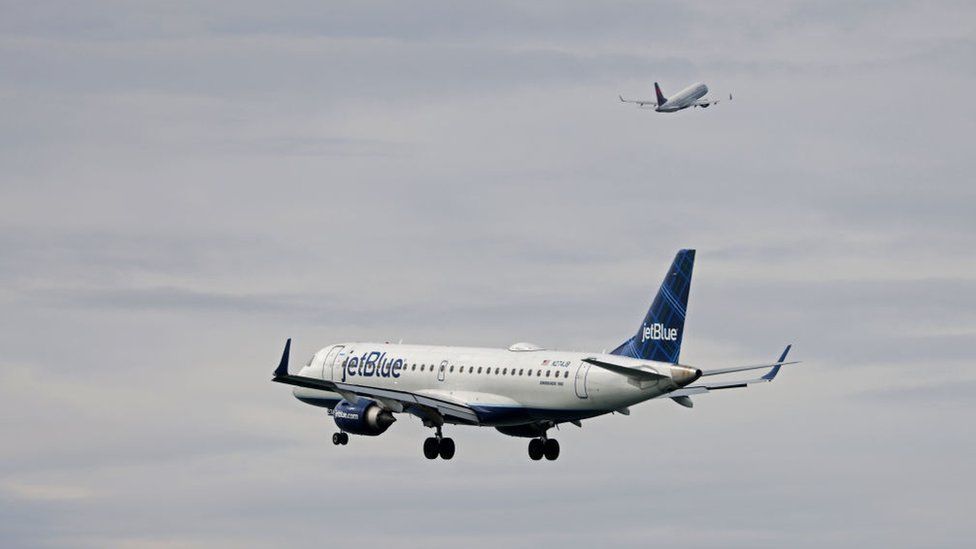ARTICLE AD BOX
 Image source, Getty Images
Image source, Getty Images
By Sam Cabral
BBC News, Washington
Surging demand for air travel and pandemic-fuelled workforce disruptions are likely to blame for a string of close calls on US airport runways.
That's according to leaders in the aviation industry, who met on Wednesday in an impromptu safety summit to address the spate of recent incidents.
The summit took place a day after the launch of yet another federal probe into a near-collision between planes.
It is the seventh aviation incident to be investigated this year alone.
Federal officials are currently reviewing six "runway incursions" - as well as one plane's terrifying nosedive and near-plunge into the Pacific Ocean - for root causes and commonalities.
The latest near-miss occurred on 7 March at Washington DC's Reagan National Airport, when a Republic Airways flight crossed a runway without clearance and forced a United Airlines flight that had already been cleared for departure to abort its take-off.
The Federal Aviation Administration (FAA), which is investigating the incident, said an air traffic controller had intervened to safely re-route the United pilot.
Officials at Wednesday's FAA-hosted safety summit agreed there had been an "uptick" in incidents, with several calling for the near-misses to be treated like real accidents.
"The absence of a fatality or an accident doesn't mean the presence of safety," said Jennifer Homendy, chairwoman of the National Transportation Safety Board. "There's always more we can do to improve safety."
The emergency summit - the first of its kind in 14 years, according to CBS News - is seen as a "call to action" for the industry and an opportunity to assess whether regulatory change is needed.
But the problem, experts say, is that airlines are still recovering from the tumult of the past three years. Not only did the pandemic fuel early retirements, mass layoffs and financial distress across the industry, but airlines went from haemorrhaging money at the start of the outbreak to being awash with customers desperate to make up for lost travel time.
According to Laura Einsetler, a commercial airline pilot with over 30 years of flying experience, the last time the industry suffered such a serious jolt was the 9/11 terror attacks, an event she argues took the sector more than a decade to recover from.
"What we're seeing now, over the past year, is this really fast ramp-up of air travel and we're trying to quickly replace that loss of 20-25% of our workers [during the pandemic] by hiring people and trying to get them up to speed right now," she told the BBC.
It all amounts to a strained aviation sector, she said, because elevated demand for air travel is probably coinciding with an overworked and under-experienced workforce.
Panellists at Wednesday's summit noted, for example, that there are 1,200 fewer air traffic controllers across the US now than there were a decade ago.
"The pressure is always there to get as many of us in and out of the airports as possible," Mrs Einsetler added. "We need to slow down and be situationally aware."
Data from the FAA shows that, while the most serious airline close calls have declined over the past two decades and there have been no fatal commercial flight accidents since 2009, the total number of incidents has grown.
Nevertheless safety experts insist it remains safe to fly in the US, arguing that widely reported recent near-misses only account for a fraction of the 45,000 flights that take place every day.
"We in the US have a very safe air transportation system," said Dr Hassan Shahidi, president and CEO of the independent Flight Safety Foundation non-profit.
"What we need to do is to make sure that we understand the root causes of these incidents and that the industry is coming together to address them in the near-term."

 1 year ago
99
1 year ago
99








 English (US) ·
English (US) ·